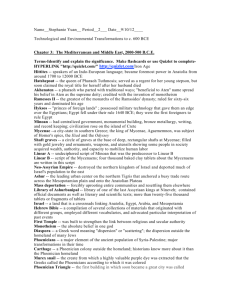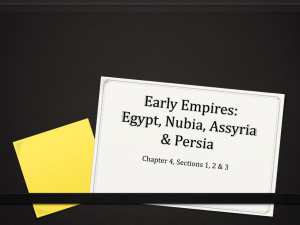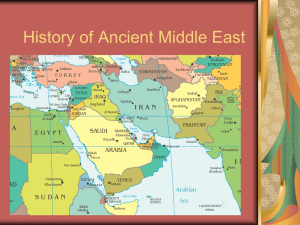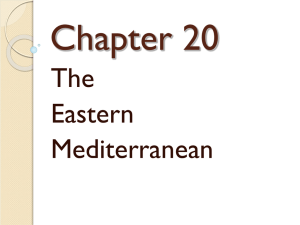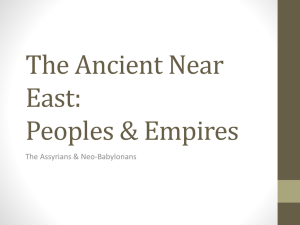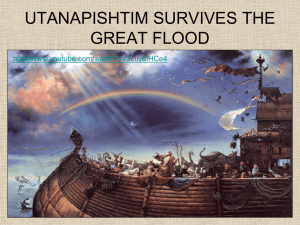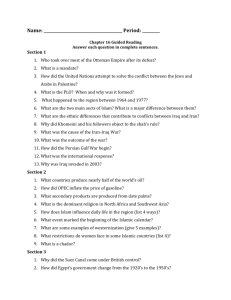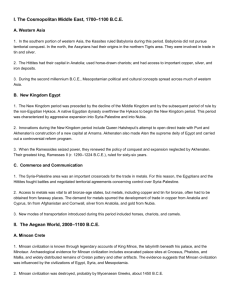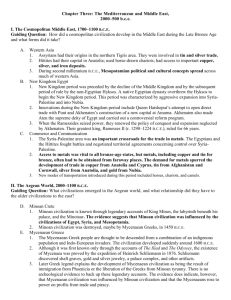Mediterranean & Middle East History Notes, 2000-500 BCE
advertisement
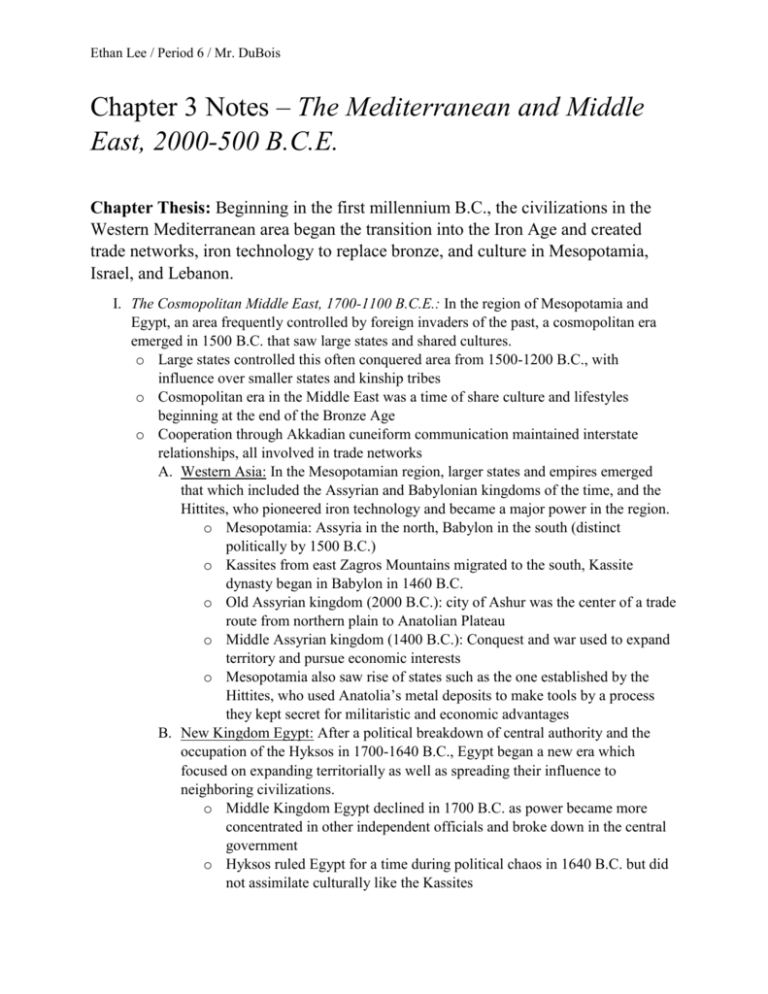
Ethan Lee / Period 6 / Mr. DuBois Chapter 3 Notes – The Mediterranean and Middle East, 2000-500 B.C.E. Chapter Thesis: Beginning in the first millennium B.C., the civilizations in the Western Mediterranean area began the transition into the Iron Age and created trade networks, iron technology to replace bronze, and culture in Mesopotamia, Israel, and Lebanon. I. The Cosmopolitan Middle East, 1700-1100 B.C.E.: In the region of Mesopotamia and Egypt, an area frequently controlled by foreign invaders of the past, a cosmopolitan era emerged in 1500 B.C. that saw large states and shared cultures. o Large states controlled this often conquered area from 1500-1200 B.C., with influence over smaller states and kinship tribes o Cosmopolitan era in the Middle East was a time of share culture and lifestyles beginning at the end of the Bronze Age o Cooperation through Akkadian cuneiform communication maintained interstate relationships, all involved in trade networks A. Western Asia: In the Mesopotamian region, larger states and empires emerged that which included the Assyrian and Babylonian kingdoms of the time, and the Hittites, who pioneered iron technology and became a major power in the region. o Mesopotamia: Assyria in the north, Babylon in the south (distinct politically by 1500 B.C.) o Kassites from east Zagros Mountains migrated to the south, Kassite dynasty began in Babylon in 1460 B.C. o Old Assyrian kingdom (2000 B.C.): city of Ashur was the center of a trade route from northern plain to Anatolian Plateau o Middle Assyrian kingdom (1400 B.C.): Conquest and war used to expand territory and pursue economic interests o Mesopotamia also saw rise of states such as the one established by the Hittites, who used Anatolia’s metal deposits to make tools by a process they kept secret for militaristic and economic advantages B. New Kingdom Egypt: After a political breakdown of central authority and the occupation of the Hyksos in 1700-1640 B.C., Egypt began a new era which focused on expanding territorially as well as spreading their influence to neighboring civilizations. o Middle Kingdom Egypt declined in 1700 B.C. as power became more concentrated in other independent officials and broke down in the central government o Hyksos ruled Egypt for a time during political chaos in 1640 B.C. but did not assimilate culturally like the Kassites Ethan Lee / Period 6 / Mr. DuBois o Kings Kamose and Ahmose drove Hyksos from Egypt and gave rise to the New Kingdom of 1532-1070 B.C. o After having been occupied for the first time, New Kingdom Egypt took a different approach and became largely expansionist, using the resources of Syria-Palestine and Nubia for timber and gold but also as buffer zones for war o Hatshepsut: only woman ruler in New Kingdom, sought myrrh by sending a naval mission to a mythical land, very showy ruler and used public displays of wealth and luxuries o Akhenaten: sometimes credited with invention of monotheism, closed temples of other Egyptian gods in favor of “Aten,” whom he believed to be the only supreme god, built a new capital, but his reforms were largely resented by priests and government officers who had roles in the traditional system, reversed later o Ramesses II: greatest ruler of the Ramessides dynasty that followed Akhenaten, which returned to expansionism and undertook monumental building projects C. Commerce and Communication: The Iron Age ushered in a time in which states traded primarily in metals, which was accelerated by the introduction of domesticated horses and camels and allowed for the development of larger states with more powerful militaries. o Treaty between Egypt and Hittites was formed after a draw battle led by Ramesses II over Syria-Palestine, which had a strategic location between Hittite Empire and Egypt as well as a point along a major Asian trade route o Trade of metals spurred long-distance trading between peoples o Domesticated horses from Central Asia were introduced to Mesopotamia around 2000 B.C. and Egypt before 1600 B.C., and allowed for larger empires and states with more mobile soldiers and horse-drawn chariots o Camels also began to be domesticated in western Asia after 1500 B.C. which resulted in new trade routes across deserts II. The Aegean World, 2000-1100 B.C.: The trade and diplomacy occurring between Mesopotamia, Syria-Palestine, and Egypt had effects on the eastern Mediterranean as well, seen by the development of the Minoan and Mycenaean civilizations in Crete and Greece. o Aegean peoples did not have many resources of metals or timber and had to import them; their success largely depended on political relations with trade partners o Rise of Aegean civilizations demonstrates influence of older empires on neighboring people groups, which take their own cue for cultural evolution and become empires A. Minoan Crete: Although there remains much more for archaeology to recover from the Minoan civilization, it is recognized as the first in Europe to have complex society and technology similar to Mesopotamia’s Hittites and Egyptians. Ethan Lee / Period 6 / Mr. DuBois o Crete became the first European civilization to have complex political structure and advanced technology similar to that of western Asia and Egypt o Ethnicity of Minoans is unclear and their ancient language has not yet been deciphered o Different views on authority suggested by vague representations of Minoan rulers, in contrast with Middle Eastern extravagant mortuary monuments and legendary descriptions o Cnossus is the only Cretan palace remaining after their destruction by (thought to be) Mycenaeans B. Mycenaean Greece: A civilization on the Greek peninsula and taking many influences from the Cretan culture of the Minoans, Mycenaean Greece was a civilization that heavily utilized long-distance, maritime trade and expansionism. o An Indo-European predecessor to the Greek language was brought to the Greek peninsula by migrants who intermarried and assimilated with the indigenous people there to form the Greek culture o 1600 B.C. brought a change from Stone Age conditions to technological advancements, revealed in archaeology through shaft graves, which were circles of graves with bodies, ornamented jewelry, and weapons o Change caused by Minoan influence of centralized government and economy, writing system, and architecture o Mycenaean palaces characterized by “fortified palace complex” of large walls, fortified structure, and located atop a hill o Linear B writing system (deciphered, early form of Greek), kept extensive records of storehouses and people but no mention of kings or political system o Shipbuilding skills of Minoans and Mycenaeans allowed for long-distance trade, supported by archaeological evidence of Greek artifacts in the Middle East o Mycenaean people were aggressive and opportunistic, had strained relations with Hittites for this reason C. The Fall of Late Bronze Age Civilizations: A perpetual collapse of civilizations occurred in the Late Bronze Age, demonstrated by the invasion of Middle Eastern civilizations and the failure of Mycenaean government, economy, and society. o Following Greek destruction of Troy (city on the edges of Hittite territory), unknown invaders in 1200 B.C. destroyed the Hittite capital and ended the kingdom o Coastal city of Ugarit in Syria was destroyed as destruction swept south; Egypt fought two invasions successfully (from Libyans and others and “Sea Peoples”), but surrendered to Philistines o Around 1200 B.C. Mycenaean centers were destroyed, despite efforts to reinforce them Ethan Lee / Period 6 / Mr. DuBois o It is thought that fall of Mycenae was caused first by destruction of major trading partners, which disrupted the ruling class and caused internal unrest leading to political collapse and the end of the Mycenaean civilization o Isolation across parts of Greece resulted in variations of Greek culture unlike homogeneous Mycenaean Age III. The Assyrian Empire, 911-612 B.C.E.: The great Assyrian Empire that resulted from the campaigns of peasant farmers led by rulers with an expansionist agenda amassed wealth and trade influence by the territories they captured. o Neo-Assyrian Empire was the most powerful and successful of those that emerged after 1000 B.C., its rulers driving peasant farmers to expand into neighboring lands o Resources were captured and international commerce secured by these war campaigns A. God and King: In the Neo-Assyrian Empire, the monarch was seen as not only a divine figure to rule over them but the chief military leader in control of all campaigns and in command of all correspondence with other people groups. o Assyrian king seen as earthly representative chosen by their gods to rule over them, being the center of the universe o King involved greatly in religion, overseeing temple maintenance, rituals, and using propaganda to win over people B. Conquest and Control: Superior engineering, organization, technology, and resources allowed Assyria to undertake many military campaigns, and they controlled their vast empire by use of force in ways such as mass deportation. o Assyria’s many successful conquests are due to their organizational and technological superiority o Iron weapons, chariots, spearmen, and half a million soldiers were at Assyria’s disposal in wartime o Mass deportation was used by the government to squelch rebellion or resistance o Assyria often had to wage campaigns to fight back control of territories previously conquered because control was very centralized and not as dispersed C. Assyrian Society and Culture: While higher classes of people worked as artisans or scribes bound to oath by the monarch, common Assyrians were rooted in the agriculture that made specialized society possible, including the extensive historical documents in the Library of Ashurbanipal. o Elite classes of Assyrian people were bound to monarch’s authority by threat of punishment and oaths o Most Assyrian subjects tended the land, specialized activities were in fact dependent on agricultural surplus Ethan Lee / Period 6 / Mr. DuBois o Assyrian scholars contributed to the literary and scientific texts of the Library of Ashurbanipal, which informs much of our understanding of Mesopotamian history as well IV. Israel, 2000-500 B.C.E.: A narrow strip of coastal land with relatively few resources, Israel’s history would become a large part of modern Middle Eastern politics, beginning in 2000 B.C. with a developing society that came from the settlement of nomadic groups. o Nomadic groups loosely related in herding became settled and agricultural, forming complex political systems and social customs to create Israel in 2000 B.C. o Religious development began with a cult of a desert god that became an allknowing deity that founded principles of Christianity, Judaism, and Islam A. Origins, Exodus, and Settlement: The Bible as a context for the history of Israel helps us understand the original pastoralists of Israel, their migration, alleged enslavement, and exodus from Egypt, and their settlement in Canaan. o The Hebrew Bible, or Old Testament, is a collection of texts that originated from different events and groups but is seen by historians as not completely accurate because much of it comes from oral tradition o Account of the Bible portrays Abraham and his descendants as pastoralists and may represent symbolically generations of these pastoralists migrating to the Mediterranean coastal plain o Israelite migration and latter enslavement in Egypt may be related to Hyksos conquest of Egypt; although little archaeological evidence attests to this, slavery of Israelites coincides with building projects of Egyptians o Exodus narrative in the Bible describes migration from Egypt and wandering in desert until the conquering of Canaan (modern day Israel and Palestinian territory, supported by evidence for destruction of Canaanite towns at that time) o It is thought that other people groups attacked Canaan with the Israelites and joined them later in settlement, fabricating a common ancestry B. Rise of the Monarchy: When the Israelites began facing conflict from foreigners, a need for a central power was realized and the monarchy formed, resulting in a unified Israelite kingdom and a time of wealth and prosperity for the empire. o Conflict with Philistines around 1200 B.C. resulted in the recognition for a need of central authority o Saul became the first king of Israel around 1020 B.C. – from Bible, as scholars see the Bible’s descriptions of the monarchy as more historically accurate o David followed Saul and brought Israel to a unified monarchy by making Jerusalem the capital, moving the Ark of the Covenant to Jerusalem, and making Jerusalem a religious center as well as a political one o Solomon, David’s son, began large building projects that would include the First Temple, which became a central shrine for their religious practices Ethan Lee / Period 6 / Mr. DuBois o Male heirs had significant importance in Israelite society, but women were respected and had some influence C. Fragmentation and Dispersal: Israel’s monarchy split into Israel (north) and Judah (south) after the monarchy’s high demands were met by the frustration of the people for not following tradition. However, although Israel was conquered by Assyria, a strong Hebrew identity remained in Judah and then in Diaspora communities and synagogues. o After Solomon’s death, resentment for royal demands and neglect of tradition led to a split between Israel in the north with the capital of Samaria and Judah in the south with the capital of Jerusalem o Despite joined attempt to resist Assyria in 721 B.C., Israel was conquered and much of its population was deported o Judah survived a century longer but Jerusalem was captured in 587 B.C. by Neo-Babylon and the royal family and skilled workers were deported; Diaspora resulted, in which the dispersion of Jews outside their homeland occurred and formed communities V. Phoenicia and the Mediterranean: 1200-500 B.C.E.: As referred to by the Israelite Bible, the Canaanites, or Phoenicians, to the north developed a unique culture and civilization. A. The Phoenician City-States: Divided naturally by the rivers of Mount Lebanon, the Phoenician city-states held autonomy in their own respect and became important hubs of trade in the region. o Mediterranean region disrupted by migrations and invasions in 1200 B.C. as aforementioned, and many Canaanite settlements were destroyed in the process o 1100 B.C. saw Canaanite territory being a narrow strip of divided small city-states in modern Lebanon; inhabitants accepted new political models and used sea commerce and raw materials trade to earn wealth o Alphabetic system of writing representing sounds developed from Canaanite models o Byblos: most important city-state before 1000 B.C. for cedar distribution o Tyre: became increasingly prominent under King Hiram, located on an island with two harbors, dominated Mediterranean coastal trade B. Expansion into the Mediterranean: In an attempt to control trade in the Mediterranean even further, Tyre colonized the island of Cyprus and spanned the entire Mediterranean with their coastal control of trade. o After 900 B.C., Tyre secured colonies on Cyprus (an island off of the Syrian coast) and formed the Phoenician triangle, completely controlling Mediterranean trade network o Tyre fell to another Assyrian army in 701 B.C. and gave way to Sidon, which became the prevailing Phoenician city-state C. Carthage’s Commercial Empire: Carthage was a Phoenician colony in present-day Tunisia that became one of the most significant cities in the early world with its dense population, ethnic diversity, social mobility, and control of trade. Ethan Lee / Period 6 / Mr. DuBois o Phoenician colony of Carthage founded in 814 B.C. – more is known about Phoenicia’s colonies because of Greek and Roman reports on wars with Phoenician communities o Citadel located on a hill with a double harbor and watchtower o One of the largest and most diverse cities in the world at the time with a population of 400,000 o Political unrest of Greece and Rome at the time not evident in Carthage, as the social system allowed for successful families to become influential citizens rather than be set in an aristocracy by birth o Power rested with navy and controlling Mediterranean sea lanes D. War and Religion: Carthaginian religion was polytheistic and was based on capricious gods whose anger must be appeased, and sometimes this went so far as to sacrifice their own children, as reported by Roman observers. o Carthage as a state ruled their small empire indirectly, allowing other neighboring Phoenician communities autonomy but providing them with military protection o Carthage focused greatly on trade and separated military command from societal government o Carthaginians worshipped terrifying gods who had to be appeased, which sometimes included sacrificing children in times of crisis VI. Failure and Transformation, 750-550 B.C.E.: As Assyria stood unchallenged by 650 B.C., having conquered most of Western Asia and a large part of the Middle East, the hatred of conquered ethnic groups, shortage of resources, Babylonian revival, and Medes attackers led to the downfall of the empire in 612 B.C. o The Assyrians conquered a large part of the Middle East: northern Israel, Tyre, and Egypt were all under Assyrian control in 650 B.C. o The frequent campaigns, however, had drained Assyrian resources and stirred anger from conquered ethnic groups o Neo-Babylonian dynasty revived Babylonia and sparked resistance against Assyria, as well as the Medes people who attacked in a campaign to extend their own Iranian territory o Medes took Assyrian homeland but most of the territory of the empire became the Neo-Babylonian kingdom
